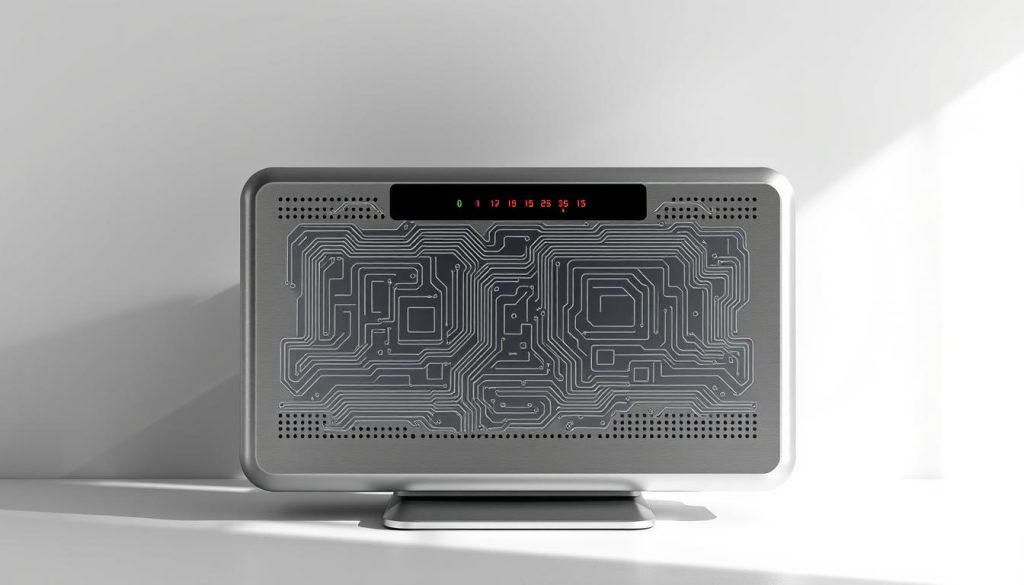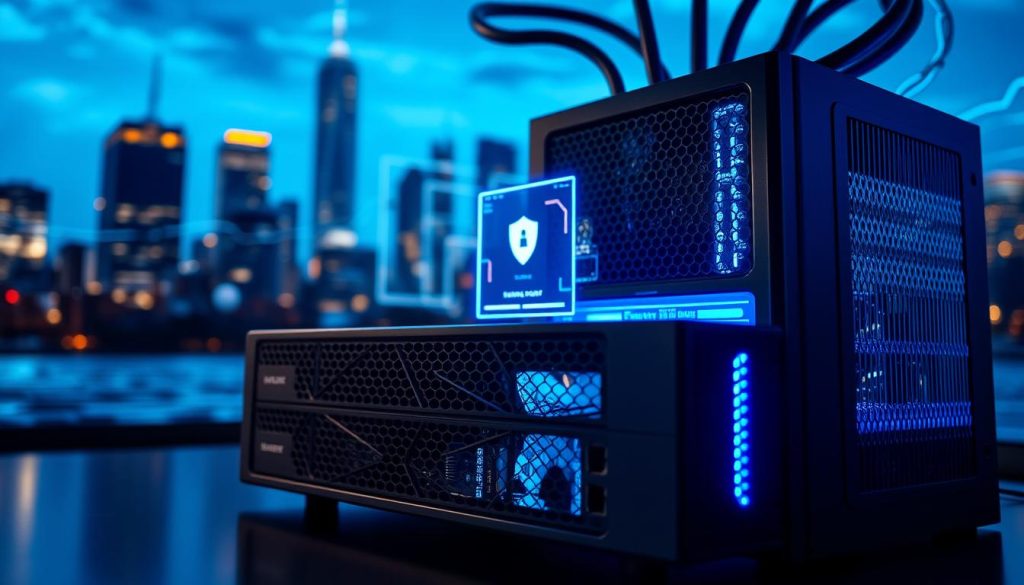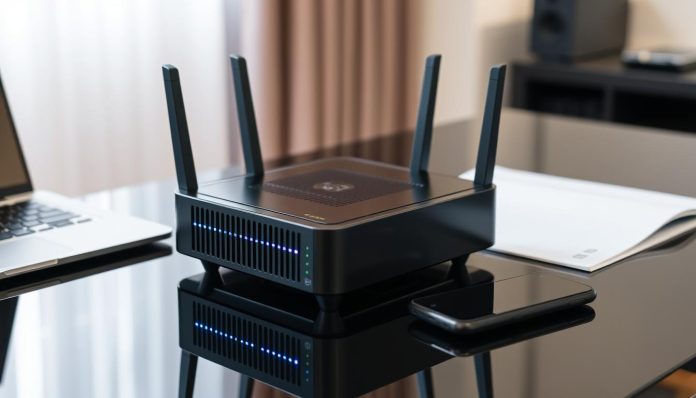In today’s digital world, securing your modem is key. It helps keep your online activities safe from ISP surveillance and cyber threats.
Your modem is the entry point to your home network. It’s a big target for bad guys. If it gets hacked, your data could be stolen, and you might face other cyber dangers.
To protect against cyber threats, you need to set up your modem right. This means changing default passwords, turning on the firewall, and updating your modem’s software.
Key Takeaways
- Change default passwords to prevent unauthorized access.
- Enable firewall protection to block malicious activities.
- Regularly update your modem’s firmware to patch security vulnerabilities.
- Use WPA3 encryption to secure your wireless network.
- Disable remote management to prevent external access.
Understanding ISP Surveillance
As you explore the digital world, knowing how your Internet Service Provider (ISP) watches your online moves is key. ISPs manage the internet’s backbone, letting you surf the web. But, they also watch your activities, affecting your privacy and safety.
What is ISP Surveillance?
ISP surveillance means ISPs track, gather, and study your internet use. They watch the sites you visit and the data you send online. They do this for ads and to keep your network safe.
Why ISPs Monitor Your Activity?
ISPs keep an eye on you for a few reasons. One big one is gathering data for ads. They use your browsing to show you ads that fit your interests, making more money. They also watch to keep your network safe and follow the law.
Knowing about ISP monitoring is the first step to protect your online privacy. By understanding their reasons, you can take steps to keep your data safe and secure online.
The Risks of Cyber Attacks
Our growing use of digital connections makes our modems vulnerable to cyber threats. It’s important to be aware and take action. As we rely more on digital tools, the dangers of cyber attacks increase. We must understand these risks.
Common Types of Cyber Attacks
Cyber attacks come in many forms, each with its own risks. Some common ones are:
- Malware: Software made to harm or exploit your device.
- Phishing: Tricks to get you to share sensitive info.
- Ransomware: Malware that demands money to unlock your data.
These threats can weaken your modem’s security. This can lead to unauthorized access to your network and data.
The Impact of a Security Breach
A security breach can cause big problems. These include financial loss, data theft, and identity theft. Here’s what can happen:
| Impact | Description | Implications |
|---|---|---|
| Financial Loss | Direct financial theft or loss due to compromised financial information. | Immediate financial impact, potential long-term financial consequences. |
| Data Theft | Theft of personal or sensitive data. | Potential for identity theft, loss of privacy. |
| Identity Theft | Unauthorized use of your identity. | Long-term financial and personal consequences, damage to credit score. |
Knowing these risks is key to protecting against cyber threats. It helps us keep our network device security strong.
Setting Up Strong Passwords
Protecting your modem from unauthorized access starts with strong, unique passwords. This is key to securing your modem and stopping cyber attacks.
Choosing a Strong Password
A strong password is your first defense against cyber threats. To make a good password, follow these tips:
- Length: Aim for a minimum of 12 characters.
- Complexity: Mix uppercase and lowercase letters, numbers, and special characters.
- Uniqueness: Avoid using easily guessable information such as your name, birthdate, or common words.
Using a password manager can help generate and store complex passwords securely.
| Password Characteristics | Weak Password | Strong Password |
|---|---|---|
| Length | Short (e.g., 6 characters) | Long (e.g., 12+ characters) |
| Complexity | Simple (e.g., “password123”) | Complex (e.g., “Giraffe#LemonTree88!”) |
| Uniqueness | Guessable (e.g., “JohnDoe1980”) | Unpredictable (e.g., random combination of characters) |
Changing Default Admin Credentials
Many modems and routers have default admin credentials that hackers can easily find. Changing these defaults is crucial for securing your device.
To change the default admin credentials:
- Log in to your modem’s admin interface using the default credentials.
- Navigate to the admin settings section.
- Enter a new, strong password following the guidelines above.
- Save your changes to update the admin credentials.
Remember, keeping your admin credentials secure is vital to preventing unauthorized access to your modem.
Updating Firmware Regularly
Updating your modem’s firmware is a simple yet effective way to bolster your network’s defenses. Regular firmware updates are essential for patching security vulnerabilities. They ensure your modem or router remains secure against emerging cyber threats.

Importance of Firmware Updates
Firmware updates often include patches for security vulnerabilities that have been discovered since the last update. These patches are crucial for protecting against cyber threats that could compromise your network. Moreover, updates can improve the overall performance and stability of your modem, enhancing your internet experience.
Outdated firmware can leave your network exposed to attacks. Hackers frequently target known vulnerabilities in older firmware versions. By keeping your firmware up to date, you significantly reduce the risk of your network being compromised.
How to Check for Firmware Updates
Checking for firmware updates is typically a straightforward process:
- Log in to your modem’s admin interface using its IP address (commonly 192.168.0.1 or 192.168.1.1).
- Navigate to the firmware update section, usually found under ‘Advanced’ or ‘Administration’ settings.
- Check if there is an update available and follow the on-screen instructions to download and install it.
It’s also a good practice to enable automatic firmware updates if your modem supports this feature. This ensures you receive updates as soon as they are available without having to manually check.
| Firmware Update Benefits | Description |
|---|---|
| Security Patches | Fixes vulnerabilities that could be exploited by hackers. |
| Performance Improvement | Enhances the overall speed and reliability of your network. |
| New Features | Sometimes adds new functionalities or improves existing ones. |
By regularly updating your modem’s firmware, you contribute to enhanced modem security and protect your network against the latest cyber threats. Make it a habit to check for updates periodically to keep your network secure and running smoothly.
Configuring Your Network Settings
To keep your network safe from surveillance and cyber threats, setting up your network settings is key. Proper settings can greatly boost your online security.
Disabling WPS for Increased Security
Wi-Fi Protected Setup (WPS) makes adding devices to your network easy. But, it has weaknesses that hackers can use. Disabling WPS helps keep your network safe from unwanted access.
To turn off WPS, go to your router’s settings in a web browser. The steps might differ based on your router. But usually, you’ll find WPS in the wireless settings.
Hiding Your SSID
Your SSID (Network Name) identifies your Wi-Fi network. Hiding your SSID makes it harder for others to find and join your network. It’s a good step when combined with other security measures.
| Security Measure | Purpose | Benefit |
|---|---|---|
| Disabling WPS | Prevents easy exploitation of WPS vulnerabilities | Enhanced security against hacking attempts |
| Hiding SSID | Makes network less visible to unauthorized devices | Reduced risk of unauthorized network access |
By making these network changes, you can greatly improve your network’s security. This helps protect against surveillance.
Utilizing Firewall Protection
A firewall is like a strong shield between your network and the internet. It keeps out bad traffic. By setting up your firewall right, you can make your modem safer and fight off cyber threats.

What is a Network Firewall?
A network firewall is a system that watches and controls network traffic. It follows rules to block bad traffic, like hacking and malware. This keeps your network safe.
Firewalls can be hardware, software, or both. Most modems have a firewall built-in. But, make sure it’s turned on and set up right.
Tips for Configuring Your Firewall
Setting up your firewall right is key to its success. Here are some tips to help you:
- Enable the Firewall: Make sure your modem’s firewall is on. You can do this through the modem’s web interface.
- Configure Rules: Create rules to manage traffic. You can block certain IP addresses or ports.
- Update Firewall Firmware: Keep your firewall’s firmware updated. This helps fight off new threats.
- Monitor Firewall Logs: Check your firewall logs often. This helps spot and fix security issues.
| Firewall Configuration Tips | Description | Benefits |
|---|---|---|
| Enable Firewall | Activating the firewall on your modem | Blocks malicious traffic by default |
| Configure Rules | Setting specific rules for network traffic | Customized security based on your needs |
| Update Firmware | Keeping the firewall’s firmware up-to-date | Protection against the latest security threats |
By following these tips, you can make your modem much safer. Using a firewall is a big part of keeping your network safe. It’s a key step in protecting against cyber threats.
Enabling VPN for Added Privacy
To keep your data safe from surveillance, using a VPN is key. A Virtual Private Network (VPN) encrypts your internet use. This protects your privacy from unwanted eyes.
How a VPN Works
A VPN hides your internet use by sending it through a server. It encrypts your data and hides your IP address. This makes it hard for others, like ISPs, to see what you’re doing online.
Key components of a VPN service include:
- Encryption protocols to secure your data
- A network of servers to route your connection
- IP address masking to maintain anonymity
Choosing the Right VPN Service
When picking a VPN, look at these factors for the best protection:
| Feature | Description | Importance |
|---|---|---|
| Encryption Level | AES-256 encryption is considered industry standard | High |
| Server Locations | More locations provide better access and redundancy | Medium |
| Logging Policy | A strict no-logs policy ensures your data isn’t stored | High |
Knowing how a VPN works and picking a good service boosts your online safety and privacy.
Monitoring Your Network Traffic
Keeping an eye on your network traffic is crucial for security. It helps spot potential threats early. This way, you can act fast to prevent harm. It’s key to keeping your network device security strong.
Tools for Network Monitoring
There are many tools for monitoring your network. Here are a few:
- Wireshark: Great for analyzing network traffic live.
- Nagios: Monitors devices and alerts you to problems.
- SolarWinds: Offers detailed network monitoring and management.
Identifying Unusual Activity
Unusual network activity might mean a cyber attack. Watch for:
- Unknown devices on your network.
- Strange login attempts or access requests.
- Odd data transfers or traffic patterns.
To see how different tools compare, check the table below:
| Tool Name | Real-time Analysis | Alert System | Network Device Monitoring |
|---|---|---|---|
| Wireshark | Yes | Limited | Yes |
| Nagios | Yes | Yes | Yes |
| SolarWinds | Yes | Yes | Yes |

Using these tools and staying alert can greatly improve your defense against cyber threats.
Securing Your Wi-Fi Network
A secure Wi-Fi network is key to fighting off cyber attacks and ISP snooping. As you make your modem more secure, don’t forget to protect your Wi-Fi too. This means following the best Wi-Fi security tips and knowing when to use guest networks.
Best Practices for Wi-Fi Security
To keep your Wi-Fi safe, start with strong passwords and WPA3 encryption. WPA3 is the newest security method to keep your network safe from hackers. Also, turn off WPS (Wi-Fi Protected Setup) to avoid security holes.
Here are more tips:
- Update your router’s firmware often to get the latest security fixes.
- Use a firewall to block unwanted network access.
- Create a guest network for visitors to keep your main network safe.
For better modem security, set up your router settings wisely. Change the default admin login and use a strong password for your Wi-Fi.
| Security Measure | Description | Benefit |
|---|---|---|
| WPA3 Encryption | Latest security protocol for Wi-Fi networks | Protects against unauthorized access |
| Strong Passwords | Complex passwords for network access | Prevents brute-force attacks |
| Guest Network | Separate network for visitors | Isolates visitors from main network |
Guest Networks: When and How to Use Them
A guest network lets visitors use the internet without getting on your main network. This is a big security win as it keeps your main network safe from visitors.
To set up a guest network, go to your router’s settings, usually through a web interface. Look for the guest network option and set a strong password. You might also want to limit the bandwidth and number of devices that can connect.
By following these tips and using guest networks when needed, you can make your Wi-Fi network much more secure. This helps protect your modem and overall network security.
Educating Family and Households
To keep your home network safe, teaching your family about cybersecurity is key. In today’s world, everyone in your home could face cyber threats. By teaching them about online safety, you can lower the risk of cyber attacks.
Cybersecurity Awareness: Why It Matters
Cybersecurity awareness is more than just knowing threats. It’s about knowing how to avoid them. When your family knows the dangers, they’re less likely to click on bad links or download unknown software. This knowledge helps protect against cyber threats and makes the internet safer for everyone.

Teaching Safe Internet Practices
Teaching your family to use the internet safely is vital. Start by teaching them to use strong, unique passwords for all online accounts. Also, tell them to be careful with personal info online and check websites before sharing sensitive data.
| Safe Practice | Description | Benefit |
|---|---|---|
| Using Strong Passwords | Combine letters, numbers, and special characters to create unique passwords. | Reduces the risk of unauthorized access to accounts. |
| Being Cautious with Personal Info | Avoid sharing sensitive information on unsecured websites. | Protects against identity theft and data breaches. |
| Verifying Website Authenticity | Check for HTTPS and verify the website’s identity before entering personal data. | Ensures you’re not divulging information to malicious entities. |
By teaching your family about these practices, you create a safer online environment. Talk about new threats often and remind them to stay safe online. This way, you build a strong defense against cyber threats.
Regularly Auditing Your Security
Checking your security setup is key to protecting your network. Regular audits find vulnerabilities and keep your network safe. This boosts your network device security and protects your data.
Conducting a Security Audit
Start by reviewing your modem protection strategies. Make sure your firmware is current to avoid cyber threats. Also, check that your firewall is on and set right.
- Check for any unauthorized devices connected to your network.
- Review your network settings to ensure they are secure.
- Update your passwords and consider using a password manager.
What to Look for During an Audit
Look for signs of security breaches during your audit. Watch for unusual network traffic and system performance issues. Also, check your Wi-Fi settings to ensure they are secure.
- Ensuring all devices connected to your network are authorized.
- Verifying that your security software is up-to-date.
- Checking for any suspicious activity in your network logs.
Regular security audits and fixing vulnerabilities greatly enhance your modem protection strategies and network security.
Staying Informed About Threats
Keeping your modem safe means knowing the latest cyber threats and updates. This knowledge helps you fight off cyber attacks and keep your modem secure.
Cybersecurity News and Updates
It’s important to follow trusted cybersecurity news. Sites like Cybersecurity and Infrastructure Security Agency (CISA) and SANS Institute give updates on new threats and how to avoid them.
Participating in Online Communities
Being part of online forums, like Reddit’s netsec community, is also helpful. These places let you talk to security experts and others who care about safety. It’s a great way to stay one step ahead of threats.
By staying informed and active, you can keep your modem and network safe. This protects your personal data and keeps your online life private.

